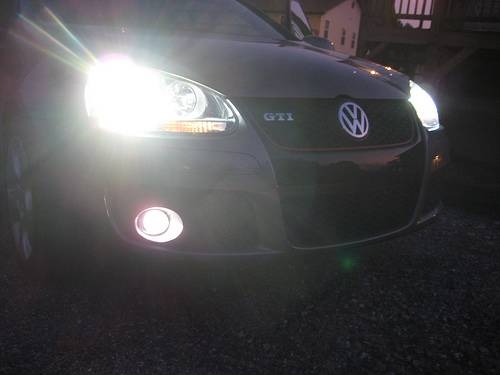
If you have ever been to a movie theater, chances are you have seen a xenon bulb at work. Most film projectors use it because of its incredible brightness. The xenon bulb is also becoming very popular on the roads. You may have noticed its bright-bluish light as a car passed you on the highway. Automotive parts stores market this bright headlight to car enthusiasts in search of an after-market part that will give their car a distinctive style. But what is a xenon bulb, and how is it different from the less expensive bulb that people use everyday?
The early incandescent light bulb used a tungsten filament inside a vacuum in order to prevent the filament from being oxidized. However, this light bulb tended to blacken over time due to a process called sublimation (or evaporation). To slow this process, manufacturers began to use nitrogen or argon, which are inert gases. These slowed the sublimation, but they also reduced the brightness of the bulb. Today, some manufacturers use other inert gases, such as krypton or xenon, to increase brightness.

The incandescent light bulb typically has a fairly simple design. When screwed into a power source, electricity travels into the bulb from one metal contact to the other, passing through the tungsten filament. The atoms of the filament are hit by the electrons, causing them to vibrate (what we call "heat" is actually vibration). Some of the electrons that are bound to the atoms of the filament are knocked to a higher level, and as they return to their original orbit, they release energy in the form of photons, giving us light, or "incandescence."
Because the typical light bulb is fairly inefficient and not bright enough for some purposes, the halogen light bulb was developed. It relies on the same process but with different materials. The halogen bulb also uses the tungsten filament, but the bulb is much smaller and is made of quartz. Also, the gas used to fill the bulb is different. Using a halogen gas allows the filament to last longer at high temperatures. Typically, the halogen gas makes up less than 1 percent of the total gases, with an inert gas, such as argon, krypton or xenon, making up the rest. Xenon gas gives the best overall performance, but at the highest cost.

Due to the rarity of xenon gas, the xenon bulb is more expensive than a typical light bulb. Also, the xenon bulb gets very hot, so it needs to be housed in quartz rather than glass, a more expensive process. The xenon bulb is commonly used in film projectors because it can provide the high output of light needed to adequately project film images onto distant screens. But its expected life for this type of use is far shorter than the typical incandescent bulb. All this adds up to making xenon bulb an expensive lighting option.
The xenon bulb is quickly becoming a popular choice for car enthusiasts who enjoy the distinctive bright-bluish light and the wide beam of xenon bulb headlights. However, the blue light from this bulb actually comes from a tint in the glass of the headlight, rather than from the xenon gas used to fill it. There is a "true" xenon bulb that has a completely different design than a typical halogen bulb. It is marketed as "xenon" or "high intensity discharge" (HID) lamps. It relies on a design that produces a short arc of electricity in a xenon-filled bulb and is more expensive than conventional headlights.